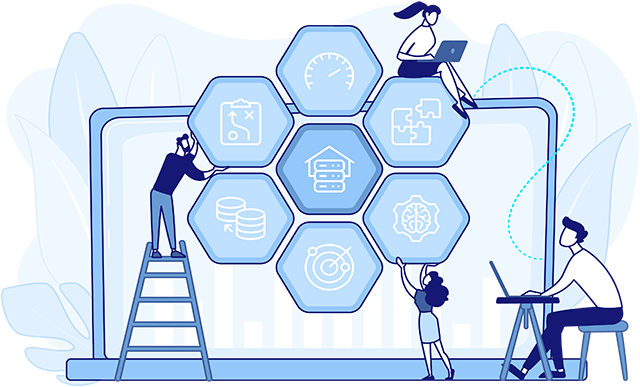The article emphasizes the critical need for robust identity security in business applications to protect sensitive data, highlighting challenges like managing excessive permissions, credential management, and the risks of overprovisioned access, while advocating for integrated Identity Governance and Administration solutions to streamline access management and mitigate these risks.
Employees, customers, and partners count on you to keep their data safe.
Key business applications, such as Enterprise Resource Planning (ERP), Customer Relationship Management (CRM), and Human Capital Management (HCM) software, contain personal private information (PII), intellectual property, financial details, and other data that must be protected to maintain trust and business continuity.
Business users, including third parties such as contractors and partners, have privileged access to critical applications. Some can not only view data but also change, download, and share it. Others can conduct activities like executing transactions and creating new users. Should this high-level access fall into the wrong hands, an external cyberattacker or malicious insider could cause significant damage.
The business owner of each application (head of sales operations, finance, HR, etc.) typically determines who requires access and may also be responsible for providing that access and managing it over time. They must collaborate with IT and security teams to ensure provisioning and deprovisioning are conducted properly, rather than operating in a silo.
In this blog, you’ll learn why it’s so important for these functions to work together so that people have the right application access to do their jobs, and nothing more. Whether you’re a business application owner, IT ops, or security leader, you’ll learn how to easily manage business user permissions to increase productivity and reduce risk.
Four identity security challenges for business applications
Strong identity security is essential for safeguarding data in business applications, just as it is for cloud resources and infrastructure managed by IT teams. For business applications, however, the scope of users with privileged access is much broader, which makes security more important, yet also more challenging. Below are four common identity security challenges specific to business applications.
- Importance of credential management
Approximately one-third (31%) of data breaches in the past 10 years stems from identity or credential compromise, according to the Verizon 2024 Data Breach Investigations Report. Protecting enterprise identities and credentials is foundational for strong cybersecurity.
Why is this challenging for business applications?
Enterprise users typically have unique identities that are managed via a directory like Entra ID, formerly Azure AD or Active Directory. Their access to enterprise tools such as email and other company-wide resources are controlled centrally through Identity and Access Management (IAM). Access to cloud infrastructure, servers, and IT applications is also managed centrally via Privileged Access Management (PAM) solutions, which provide continuous monitoring and oversight.
However, the provisioning process for business applications may not be connected to AD or another identity directory, as part of the IAM process. As a result, a user may have a different username or password for those tools than they do for others. They must remember this information and be responsible for maintaining proper identity and password hygiene—not sharing credentials with others and changing them frequently. The onus falls on application owners and users.
- The danger of excessive permissions
Should a cyberattacker obtain credentials they can conduct any nefarious activities associated with that user, including any permissions they have in business applications. To contain the blast radius, permissions should be limited.
Why is this challenging for business applications?
Each business application has a different model for authorization. Natively, most have relatively few access levels, such as an all-powerful “administer” or basic “user,” rather than granular access that account for factors such as location, time, or risk. As a result, it’s common for users to have more access than their job role requires.
- Managing Joiners, Movers, and Leavers in business applications
Identities require access to business applications when they join an organization so that they can be productive right away. Their level of access may change when they move roles or take on new projects and should be removed, or deprovisioned, when they leave an organization. Unfortunately, it’s common for users to retain entitlements long after they’re needed.
Why is this challenging for business applications?
A common example is when an employee is promoted from staff accountant to director of accounting. Let’s say the access granted as staff accountant isn’t removed, but new access required for the director role is added to their entitlement. This leads to overprovisioned access, and without processes to periodically review user access, this risk will continue.
The identity lifecycle of third-party users introduces additional risks. It’s common for contractors to move on to another job, but their access remains. Some companies rely on word of mouth or accidental input to business application owners about third parties who no longer require access. Trying to keep track of third parties and their status manually isn’t scalable.
- Segregation of Duties (SoD) conflicts for business application users
How often do you conduct a preventative check for any access conflicts before provisioning entitlements for business application users?
Why is this challenging for business applications?
Because IT and business application provisioning processes are siloed, it’s impossible to tell the full extent of access any identity has or accurately measure your identity security risk posture.
Many business applications don’t natively provide functionality to check for SoD conflicts, such as setting up vendors and having the ability to process payments to them. Failure to do so introduces risk of fraud into the organization.
How to break down silos with integrated Identity and Access Governance
Business application owners aren’t experts on identity security best practices. As such, if they aren’t provided guidance and easy-to-use solutions to manage access control to their applications, they’re forced to struggle on their own. This leads to manual provisioning processes, access controls that are lacking, and operational inefficiencies such as help desk requests, email requests, and even verbal requests between users and the business application security administrator, who, in many cases, isn’t a member of the IT department.
These fragmented processes, including disconnected tools for managing identities and access, introduce risk.
These silos must be removed.
Business application owners should work in parallel with CISOs and CIOs who own security and risk. Consolidating access provisioning onto an identity security solution is the way forward. Identity Governance and Administration (IGA) solutions support the provisioning processes for business applications so that they align with security best practices and reduce risk.
With IGA you can grant the specific access required to align with least privilege requirements. Additionally, since IGA solutions automate provisioning and deprovisioning, granting access directly in business applications, you can avoid the errors introduced by manual processes. IGA solutions can have an SoD check built in, so that you can review granular permissions BEFORE setting up users with access to a business application.






